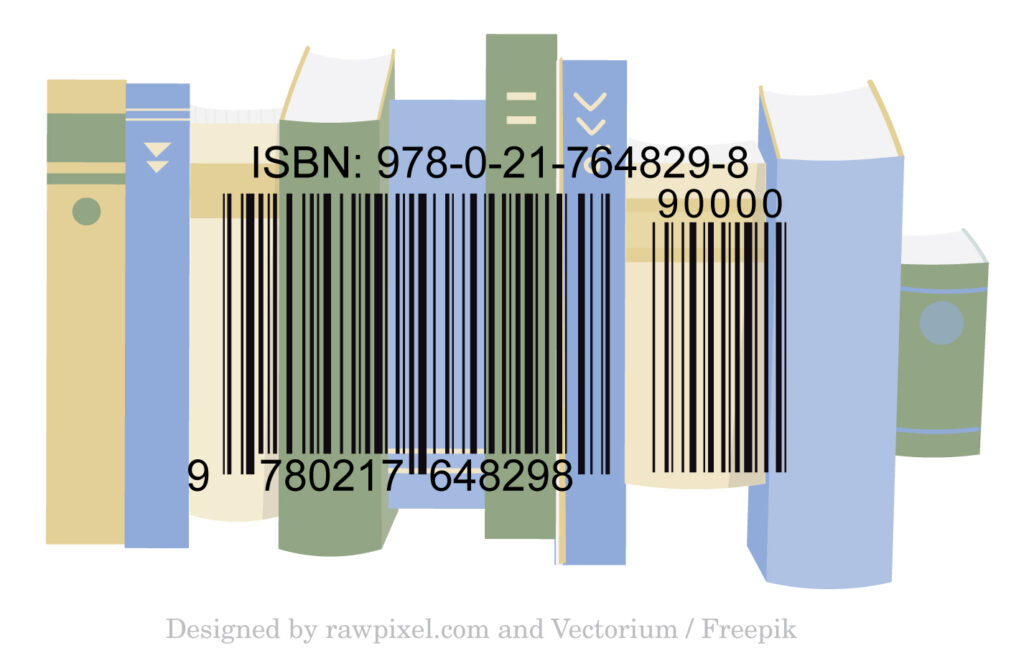By Shaina Lucas, PPS Editor — If you’ve ever bought a book and looked at a copyright page or back cover, you will notice its unique number. All books have these. So what are they? These numbers are an ISBN, which stands for International Standard Book Number. Why is this number important in the publishing world? Let’s delve into the details.

What’s the Purpose?
Every published book has this 13-digit number printed on the back cover and on the copyright page. According to isbn.org, “the purpose of the ISBN is to establish and identify one title or edition of a title from one specific publisher and is unique to that edition, allowing for more efficient marketing of products by booksellers, libraries, universities, wholesalers, and distributors.” In essence, this number is like a tracking device for a book.
The numbers are always preceded by “ISBN” to easily identify it, and it is divided into four parts: the group or country identifier that identifies a national or geographic group of publishers; the publisher identifier within the group; the title identifier, which marks a particular title or edition of that title; and the check digit, which is the single digit at the end of the ISBN and serves as a validator. There are variations to this, such as the use of “X.” An uppercase “X” can appear in the check digit area instead of the numeral 10. The “X” is no longer used today since expanding from the original 10-digit identifier in 2007. Today, there is a fifth part, which consists of 979 or 978 at the beginning of the digit. Why 979 and 978? These two sets of numbers were made available by the GS1, which is a nonprofit organization that develops and maintains global standards for business communication. Both 978 and 979 are the European Article Numbers (EAN), in other words, the country code of where the book has been published. The EAN is a barcode that acts as a numbering system. This system is then used in the global trade market to identify a specific retail product type, packaging configuration, and manufacturer. This beginning three-digit segment is now available to be officially registered with the International ISBN Agency so books can be published and tracked across the world.
Why Do Books Need This Number?
An ISBN is very important in publishing, not only for the reasons discussed earlier, but also because it does so much more than provide tracking. This number also provides easy access for searching, such as trying to buy a specific book on Amazon or looking it up in the Library of Congress. The ISBN is also your way toward making money. Typically, on the back of a book cover, the ISBN is accompanied by a barcode where sellers can easily scan and track sales of that particular book. Since the 1990s, ISBNs have been the way to track book sales in electronic systems across the world. According to Book Machine, books with ISBNs can quickly be checked for stock and processed efficiently for sales data. Bookshops typically steer away from books without a barcoded ISBN because they would have to process each book manually, and that could cause errors, increased costs, and inefficiencies.
ISBNs, however, are not solely for books, print or digital. ISBNs are also used for CDs, audiobooks, microforms, and even PDFs. This number cannot guarantee you make sales, but it’s an important step in the publishing process. An ISBN will not provide any legal or copyright protection, but some countries require that an ISBN be used to identify publications.
How Do I Get an ISBN?
Obtaining an ISBN is easier than you think. Publishers are responsible for getting the ISBN, and the best place to start is with the U.S. ISBN Agency. ISBNs can be assigned to both publishers and self-publishers in quantities of 1, 10, 100, 1,000, 10,000, or 100,000. Take heed, however. If your book is both print and digital, it needs to have two different ISBNs because they are two different medias. Also, if the book is in different languages, a separate ISBN will need to be purchased for each language.
If you are a publisher that is new to the publishing world, you’ll have to apply for the ISBN publisher prefix. After that, acquiring an ISBN does come at a cost and the cost will depend on either you are purchasing one or a bundle of them. But be careful, purchasing An ISBN at a special offer price, like a sale or cheaper than the standard fee noted by the ISBN Agency, these tend to be unauthorized resellers. The selling of ISBNs at a cheaper cost, or what seems to be a discounted sale, is a violation of the ISBN standards. After the ISBN is purchased, there are three different amounts of time it can take to receive the numbers. With nonpriority processing, it can take about five business days. Priority processing takes about two business days. The fastest method, express processing, takes 24 business hours but will cost more than priority and nonpriority processing. Once the ISBN, or ISBNs arrive, each one will need to be registered with the U.S. ISBN Agency. This allows your work to be listed in a special searchable database. However, there are some exceptions. An ISBN is not needed if the publisher chooses to sell the books or other media privately and not with any physical or online bookstores or wholesalers like Amazon or eBay.
Is an ISBN just a number? Technically yes, but it’s also the backbone of your book’s identifier and will help with part of the publishing process. With an ISBN, you can now have your work listed in an international database to be found all over the world, and you can track not only where it’s being sold, but also the amount of money it’s making from sales. This unique code provides the ability to see the broken-down statistics for your work, and that is pretty cool.